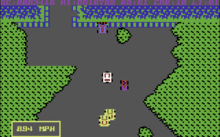Bump 'n' Jump
| Bump 'n' Jump | |
|---|---|
|
1982 arcade flyer | |
| Developer(s) |
Data East Sakata SAS (programming - NES) |
| Publisher(s) | Vic Tokai (NES) |
| Composer(s) |
Hiroaki Yoshida (NES) Azusa Hara (NES) |
| Platform(s) | |
| Release | 1982 |
| Genre(s) | Driving |
| Mode(s) | Single-player, multiplayer |
| Cabinet | Upright, cocktail |
| CPU | 1x 6502 @ 750 kHz |
| Sound | 2x AY-3-8910 Namco WSG @ 1.5 MHz MHz |
| Display | Raster, 240 x 256 pixels (Vertical), 16 colors |
Bump 'n' Jump, known in Japan as Burnin' Rubber (バーニンラバー Bānin Rabā), is a 1982 Japanese arcade game created by Data East Corporation, released as both a dedicated board and as part of their DECO Cassette System. The game was published in North America by Bally Midway.
In Bump 'n' Jump the goal is to drive from the beginning of a level to the end while bumping enemy vehicles into obstacles and jumping over various large obstacles such as bodies of water.

Gameplay
Due to the bird's eye view, players cannot see the large obstacles until it is too late to jump, so the game displays a flashing exclamation point when the large obstacles are about to appear.
The enemy vehicles are separated into cars and trucks. Cars can be bumped into obstacles or jumped upon and destroyed, while trucks cannot be bumped; they can only be jumped upon to destroy them, and will sometimes drop obstacles that will destroy the player or one extra life. At the end of each level players receive bonus points for the number of enemy vehicles crashed. Going from one level to another is characterized by a change of seasons. Players get points for bumping other cars and causing the other cars to crash, but one bonus isn't apparent: If the player completes a level without destroying another car by bumping it or jumping on it, the player receives a 50,000 point bonus (note: cars that run into the debris dropped by dump trucks on their own -- not bumped into it -- do not count against the player toward the bonus).
Ports
Mattel Electronics licensed Bump 'n' Jump from Data East and in 1983 released an Intellivision version and then a version for the Atari 2600. They also produced a version for Coleco Vision distributed by Coleco in 1984.[1][2][3][4]
The Nintendo Entertainment System version was published by Vic Tokai in 1988.[5] The NES version was previously released in Japan as Buggy Popper (バギー・ポッパー Bagī Poppā) in 1986. Adding a level of complexity, the NES version of the game also requires that players pick up cans of gasoline that are interspersed throughout each course, as their car uses up fuel steadily throughout the game if the car goes too fast.
The Commodore 64 saw two unlicensed conversions. Burnin Rubber in 1983 uses the chorale parts of Johann Sebastian Bach's Herz und Mund und Tat und Leben cantata for the soundtrack. Bumping Buggies was produced in 1984.
Reception
In 1996, Next Generation listed it as number 65 on their "Top 100 Games of All Time", lauding the innovative jumping and bumping mechanics, the variety of cars, and the strong sensation of speed and tension.[6]
Highest score
On 25 December 2011, Charlie Wehner of Missouri beat the Bump 'n' Jump world record with a score of 3,175,880.[7] On 14 September 2013, John McNeill of Brisbane, Australia claimed the world record with a score of 5,869,264 however due to ownership issues with Twin Galaxies at the time, the score was not officially recognised until January 5, 2015.[8]
The world record using MAME was achieved by John McNeill of Brisbane, Australia on 2 March 2012 with a score of 2,531,168.[9]
See also
- Spy Hunter, another game where the player can bump vehicles off the road
References
- ↑ https://www.gamefaqs.com/company/4308-mattel
- ↑ https://www.gamefaqs.com/c64/566389-burnin-rubber
- ↑ https://www.gamefaqs.com/intellivision/576726-bump-n-jump
- ↑ https://www.gamefaqs.com/colecovision/585462-bump-n-jump
- ↑ https://www.gamefaqs.com/nes/587164-bump-n-jump/data
- ↑ "Top 100 Games of All Time". Next Generation. No. 21. Imagine Media. September 1996. p. 48.
- ↑ "Twin Galaxies' Bump 'n' Jump High Score Rankings". Archived from the original on 29 October 2013. Retrieved 7 September 2012.
- ↑ "Twin Galaxies' Bump 'n' Jump Score Submission". Retrieved 28 May 2015.
- ↑ "Twin Galaxies' Bump 'n' Jump High Score Rankings". Retrieved 8 June 2013.
External links
- Bump 'n' Jump at the Killer List of Videogames
- The ColecoVision prototype version of Bump 'n' Jump can be played for free in the browser at the Internet Archive